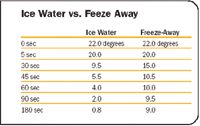- Acne
- Actinic Keratosis
- Aesthetics
- Alopecia
- Atopic Dermatitis
- Buy-and-Bill
- COVID-19
- Case-Based Roundtable
- Chronic Hand Eczema
- Chronic Spontaneous Urticaria
- Drug Watch
- Eczema
- General Dermatology
- Hidradenitis Suppurativa
- Melasma
- NP and PA
- Pediatric Dermatology
- Pigmentary Disorders
- Practice Management
- Precision Medicine and Biologics
- Prurigo Nodularis
- Psoriasis
- Psoriatic Arthritis
- Rare Disease
- Rosacea
- Skin Cancer
- Vitiligo
- Wound Care
Article
OTC cryotherapies not so cold
With these OTC products, one observes superficial frosting that can last for seconds to a few minutes, but its relevance is debatable.
Toledo - Cryosurgery is a frequently used procedure in dermatologists' offices, selectively necrosing various benign, premalignant and malignant lesions.

Recently, several over-the-counter freezing agents have appeared on the market for the self-treatment of warts. Some patients mistakenly believe that these products are synonymous with in-office cryotherapy.
Materials and methods

The spongy applicator tip was then pressed with moderate pressure continuously for three minutes against an EVER-SAFE thermometer which was calibrated from minus 20 C to 110 C. The suggested treatment duration of treatment is from 10 to 40 seconds depending upon location of the wart. Temperatures were taken at various intervals and recorded.
With all testing, the thermometer recorded room temperature, or 22 C at the start. For comparison, the thermometer was also placed into a cup of icy water and the same temperature recordings were made (see table).
As a comparison, the thermometer was also placed in a Styrofoam cup of liquid nitrogen. Within five seconds, the temperature readings was below the capabilities of our thermometer.
The best freezing times using Dr. Scholl's Freeze Away are displayed in the table.
Results and discussion
Following the package insert directions, Dr. Scholl's Freeze Away caused some visible frosting to the applicator tip, but the temperatures achieved were not as cold as ice water at any of the time intervals. Additionally, there was no rapid cooling.
Of note, the temperature of the cryogenic agent is lessened by the applicator system utilized. The coolant had to pass through a 3.3 cm plastic tubing as well as a 1.3 cm foam swab. Only the most distal portion of this applicator touches the skin (or, in this case, the thermometer). Holding the applicator into the opening in the aerosol for 15 seconds, rather than the suggested three seconds, minimally improved the freezing.
The mixture of dimethyl ether with propane in liquid form was obtained by holding the applicator for prolonged durations where it collected in the plastic holder. The temperature of this solution was easily lower than the minus 20 C on our measurements, and the speed of freezing was comparable to liquid nitrogen.
Canisters of similar cryogens with extender tubes, as used in veterinary medicine, do achieve lower tissue freezing levels. For example, Histofreeze (Fisher) has this type of packaging with tetrafluoroethane, a different coolant.
Newsletter
Like what you’re reading? Subscribe to Dermatology Times for weekly updates on therapies, innovations, and real-world practice tips.















